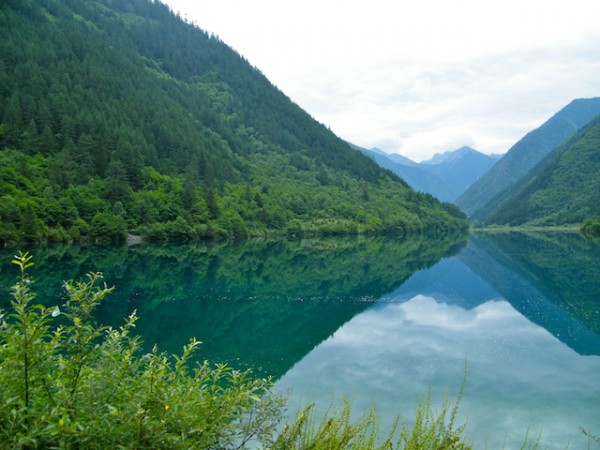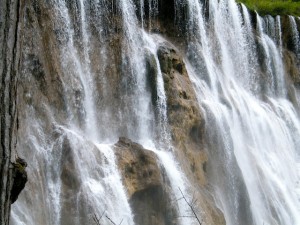As you head into China’s heartland, the terrain becomes rugged and beyond Qinling Mountain are the towering Min Shan peaks, concealing what is known to the Chinese as the Fairyland Paradise – the amazing Jiuzhaigou Valley.Yuan Li travelled there with friend Simon McSweyn to experience this enchanting place.
Are you in search of Shangri-La? I found it in the northern Sichuan provincial nature reserve that borders Tibet and attracts millions of tourists every year.
As we entered the reserve, we came upon a world that was ‘upside down’. The reflections off Jinghai (Mirror Lake) will convince you that there are birds flying in the water and fish swimming in the clouds. Blue sky, mountains and green trees are all reflected in the lake. Underwater, there is a perfectly preserved ghostly forest, as if a sheet of glass is protecting it from the rest of the world.
The silence and isolation of this world is humbling.
My friend Simon was wide-eyed: “I have never seen anything like this before. So many different colours!”
Legend has it that a beautiful goddess, Semo, would come to the lakeside to wash her face. The vivid colours result from the make up running off her face and into the lake. Judging by the spectacular scene, she must have been very beautiful.
Further along the lake, water passes through cliffs that form waterfalls with thunderous roars that echo throughout the valley. As we made our way through the primeval forest, the sun shone through the thick foliage as the falls crashed down with an explosion of mist and rainbows in an awesome display of the extraordinary power of nature.
The path then led us back to the village where we met up again with typical modern consumerism.
Jiuzhaigou derives its name from nine Tibetan villages that once ran along its length. The average altitude of the valley is approximately 2500 metres and it consists of three small valleys arranged in a Y shape.
Today most of the inhabitants of Jiuzhaigou have moved out of the reserve so the tourism association can maintain the area’s pristine beauty.
Simon met a Tibetan woman who tried to sell him a belt covered with beige and dark brown agates. She had wrinkles on her face and her skin was dark and parched. She wore a cobalt blue turban, a pink top and a brown one-shoulder gown, with matching azure-coloured jewellery.
She threw the belt around Simon’s neck and dragged him towards her. Simon did not say anything but I saw he was nervous. She then took a calculator out of her small messenger bag and her fingers thumped the buttons.
“Cheap! Cheap!” she shouted in English and shoved the calculator towards his face.
“500 Yuan? That’s ridiculous!” Simon said. He took the calculator and typed the number ‘2’, then showed her, smiling cheekily.
“Huai ren! Bad!” This time she shouted in both Chinese and English, though Simon knew what ‘huai ren’ meant. She snatched the calculator back and tried to use it to strike him, missed and gave us both a nasty look as she walked to the other side of the shop mumbling to herself.
“Crikey,” Simon said as we fled the shop, “and she thought I was the ‘bad guy’!”
 As we moved on, the road started to slope upwards. On top of the rise stood a small two-storey house with two Qilin sculptures sitting on each side of the gate.
As we moved on, the road started to slope upwards. On top of the rise stood a small two-storey house with two Qilin sculptures sitting on each side of the gate.
According to local mythology, Qilin is a beast with the head of a dragon, the antlers of a deer, the skin and scales of a fish, the hooves of an ox and the tail of a lion. In Chinese culture, Qilin is a good omen of prosperity.
The gate reminded me of the gate at Sydney’s Chinatown, although much smaller. Two Tibetan gods are beautifully painted on each side of the gate, protecting the people who live inside. A man came out of the house and ran towards us. “Ni hao, ni hao!” he yelled. “Hi,” Simon said in a strong Australian accent. The man explained that he wanted to show us his Tibetan-style house, for a fee.
As we entered the house, a strong smell of animal fur and burning incense thickened the air. A gold-coloured Buddha sculpture glittered inside a shrine in the middle of the living room. It was as though we had entered a temple.
We were then lavished with a good serving of typical generous Tibetan hospitality. The man’s wife put away her work when we walked in, picked up a Khata – a traditional ceremonial scarf symbolising purity and compassion – from a table and came towards us.
“Tashi Delek,” she welcomed us with the traditional Tibetan greeting. “Please accept my blessings.” She bowed, holding the Khata with both hands in front of us.
Simon hesitated, not sure if he should accept. I nodded, even though I was unsure of how to respond.
The man noticed our discomfort and laughed.
“Tell your friend it’s a symbol of friendship…. and, we won’t charge you.”
The man’s wife left the room smiling. We were invited to sit at a large table at the back of the room. The lady of the house returned and poured hot creamy light-brown liquid into bowls on the table. The liquid looked like thick creamy noodles, and my mouth was beginning to water.
It was delicious.
As Simon and I left after being forced to eat too much soup, we agreed it had been a very pleasant experience.
We left our Shangri-La with a new appreciation of the nature and culture of the area, enriched with a new perspective on beauty and respect for Tibetan traditions.




